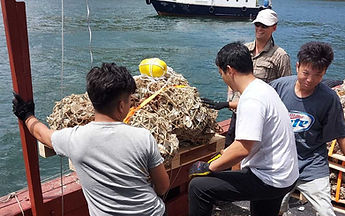
Ecological restoration with oyster shell reefs
About Sham Wan
Lamma island, the third largest island in Hong Kong, is characterized by its prevailing natural shoreline that nurtures species of high conservation value such as coral species and the endangered Green Turtle. The expansion of the restricted area and extension of the restricted period from 1 June to 31 October at Sham Wan will reduce disturbances to the breeding and nesting of green turtle by active boating and fishing activities in the bay and also provides a unique opportunity to design, implement and evaluate artificial reefs based on natural components to further enhance marine biodiversity and ecosystem functions of the bay.

Photography : AFCD
Project Aims
Oyster reefs provide valuable ecosystem services like water filtration, coastal protection, and providing habitat for fish. However, it is estimated they have declined up to 85% around the world because of overharvesting, disease, and anthropogenic impacts like pollution. Artificial reefs (ARs) are capable of supporting a similar community of species to natural reefs, if reef structure is taken into consideration.
The overarching objective of this project is to design, implement and evaluate natural-based ecologically engineered solutions, such as oyster shell reefs (as habitat for other species and recruit filter feeder species), to increase habitat complexity and enhance biodiversity and ecosystem functions in Sham Wan, Lamma Island. The implementation of artificial reefs made of oyster shells will be used to increase environmental complexity and promote recruitment of species of multiple trophic levels.



Site Map

Source: Google Earth

Materials
&
Methods

Locally grown native Hong Kong oyster shells were sourced from Lau Fau Shan, Hong Kong.

Oyster shells were packed into hemp bags. 240 bags, ~15kg per bag,

Oyster shells were packed into stainless steel bags. 240 bags, ~15kg per bag,

The reef structure is arranged so that 4 shell bags sat on the lowest layer, with 3 shell bags perpendicularly laid on top in the middle layer, and finally with 2 shell bags perpendicularly laid on top in the upper layer.

Oyster shells were packed into hemp bags. 240 bags, ~15kg per bag,
Process of deployment
At Sham Wan, a barge winch was used to pull and hoist the reef units to the side of the boat where they were dropped into the water at random locations along the selected trial site transects.






